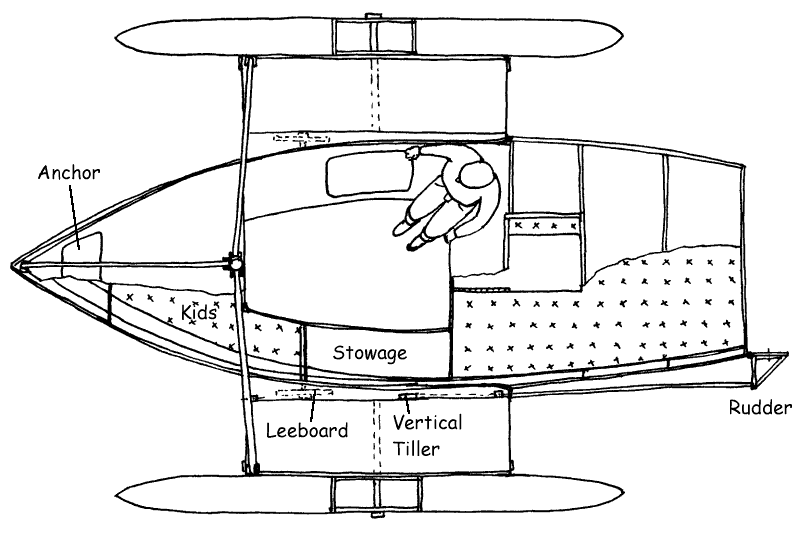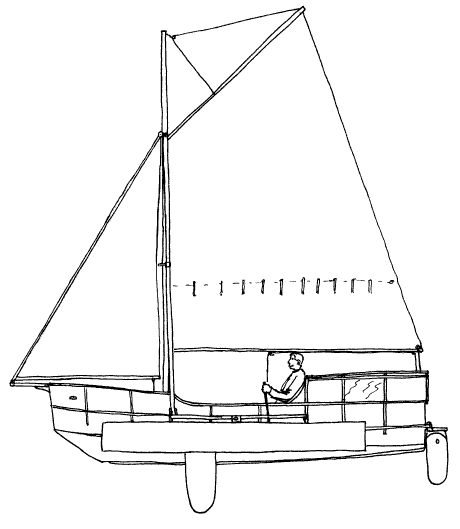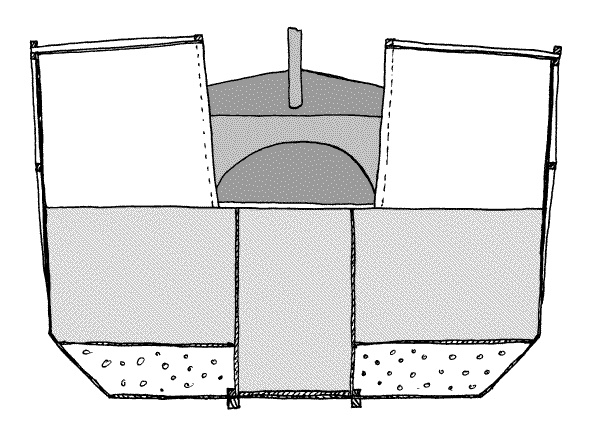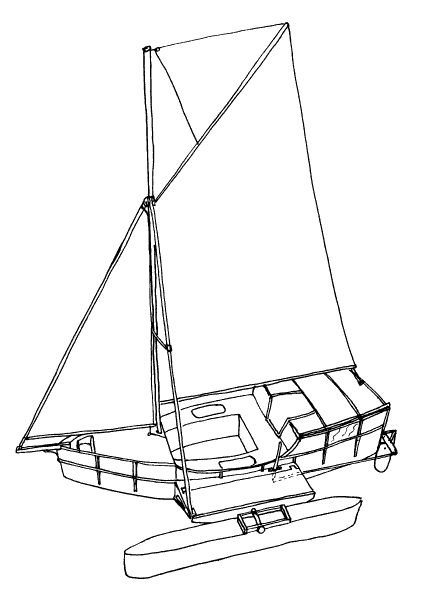|
5m folding tri
Design by Horst Werner werner@cad.uni-sb.de
| LOA |
5.5 m |
 |
| LOD |
5 m |
| LWL |
4.70 m |
| Beam (max) |
3.50 m |
| Beam (on trailer) |
1.90 m |
| Mast height over WL |
5.77 m |
| Sail area |
14 m2 (main 10.4 m2, jib 3.6 m2) |
| Weight empty |
250 kg |
| Load capacity |
480 kg |
| Cabin headroom |
0.95 m over berth |
| Draught (leeboards down) |
0.80 m |
| Draught (leeboards & rudder up) |
0.18 |

Design Philosophy:
This boat is designed consequently for trailering, which means that it is easy
to handle by two persons, can be towed even with a small car and should take not more than
20 minutes to be ready to sail.
It will carry 6 adults for daysailing and two adults (and maybe 2 kids) for cruising.
Accomodation is very basic, but sitting headroom is provided over the whole cabin length.
Cooking can be done ashore or in the cockpit (under a boom tent when the weather is bad).
Despite of its small size the boat offers relatively much living space: The cockpit is
1.80 m long and 1.70 m wide, further extended by two platforms of 60 cm width. The aft
cabin is only 1.60 m long but offers two 2 m berths extending under the rear bench of the
cockpit. |

As for sailing performance, safety is stressed rather than speed. Each of the amas
provides 350 kg of buoyancy, yet the sail area is chosen relatively small. But even though
speed was not a primary objective, I think the tri should plane if there is enough wind,
since it is light and has a flat bottom which is about 1.25 m wide over almost the whole
length. Due to the center cockpit, trim will not be affected by a large crew. The transom
will stay clear from the water surface till the nominal payload of 480 kg is reached
(which is almost two times the boat's own weight!). A boom jib makes tacking easy and also
contributes to safetyStyling
Even if the outer appearance reminds of ancient sailing ships, almost every detail is
caused by functional aspects: The aft cabin is needed to put the crew weight towards the
center of displacement, i.e. the middle of the boat. The raised foredeck supports the ama
together with the aft deck when the tri is folded for trailering. It also provides a small
"cabin" for the kids, a dog or just lots of stowage. The raised foredeck should
also protect the crew from spray to a certain degree.
The gaff rig is needed because the mast had to be placed far to the bow. The bowsprit
allows for a reasonable size of the jib. The ribs on the outside are needed to stiffen the
thin plywood (5 mm) without interfering with the interior space, especially in the cabin. |
 
Safety Aspects
Apart from the modest sail area, there are several features emphasizing safety. First
of all the double bottom, wich contains 20 cm of styrofoam over almost the whole length.
Thus a self-bailing cockpit is provided as well as unsinkability. Even serious grounding,
or maybe firing a shotgun through the bottom will barely cause wet feet.
To prevent pitchpoling, the amas can freely rotate around their center of bouyancy (or
a hub a bit more to the aft). This leads to a decoupling of lateral stability which is
provided by the amas, and longitudinal stability, which is entirely provided by the main
hull. In other words: the bows of the amas can not be forced under the surface by the rest
of the boat. Even if they cut into a wave, the enormous difference between buoyancy before
and aft of the hub should cause a self-balancing effect, since the rotation of the ama is
unhindered. In the worst case, it will rotate a full 180° and continue upside down, but
this probably can't cause the whole boat to pitchpole.
Sufficient strength is provided in spite of the lightweight construction by the way the
mast is stayed: Shrouds and forestay are replaced by aluminium tubes (40 mm x 2 mm) which
lead the sail forces directly to the amas, which means that the main hull has very low
stresses to bear. In order to prevent bending of the "shroud" tubes under
pressure, they are linked in the middle by a traverse tube passing in front of the mast,
thus forming an "A".
The outside of the mainhull is protected by one layer of fibreglass (200 g/m2),
the bottom by two layers and two wooden "keel" strips (20 x 30 mm) running over
the whole length. The following cross sections show the inner structure. The first one is
directly aft of the mast, looking to the bow. The second is a cut behind the front wall of
the cabin, also looking forward. Shades of grey are used to indicate the distance to the
viewpoint: the more distant a surface is, the darker it appears in the image. |


Building
The main hull is mainly stitch-and-glue, some wood strips are needed for the assembly
of the seat benchs and decks. Material is 5 mm Okume for the bottom and sides and 10 mm
Okume for the bulkheads (Of course, pine or fir will do as well). The whole outside and
the cockpit floor and benches are glassed. The amas are glued together from styrofoam
plates (there is a somewhat harder styrofoam called "Styrodur" in germany) and
formed with handsaw and power grinder. Then a plywood deck is glued on top and a wooden
strip on the floor. Two layers of fibreglass are laminated onto the styrofoam to protect
it.
The estimated building costs are about US$ 3000 including a used trailer. (I spent
about US$ 600 for the plywood and about US$ 400 for fibreglass and epoxy, but don't know
which unexpected costs will appear during the building process).
Folding/Unfolding
The following images taken from a cardboard model show how the boat is stored on the
trailer and how it is unfolded. Note that the amas are rotated 180° in order to point to
the inner side during transport.
Rudder and leeboards stay mounted during transport. In order to reduce setup time to a
minimum, a stump of the mast stays rigidly mounted on the hull to keep the lowered
mainsail in place (an idea I stole from the Weekender). |
"Vices"
- One problem of the aft cabin concept is that a normal tiller can not be used. This issue
is solved (I hope) by using a vertical tiller in combination with an offset rudder and a
bar with two cardanic joints between them (which has the beneficial side-effect that no
room in the cockpit is lost).
- The second issue is the placement of an outboard motor. A good place might be the rear
end of the left platform, so that the helmsman can sit on the platform to control outboard
and tiller at the same time.
- The concept of rotating amas may turn out not to work in rough sea, since once the ama
is out of the horizontal position, lateral forces can not be lead into the platform any
more, thus the axle may be loaded with serious bending momentum. Whether this is really
critical can only be decided by testing. Maybe there should be a possibility to fix the
amas completely to the platform if necessary.
- The double bottom and the ribs make the building process more time-consuming, even if
they don't add much to the material costs.
|


My name is Horst Werner, I'm a mechanical engineer and have been reading about boat
design as a hobby for three years. I'm currently working at the University of the Saarland
in Saarbrücken/Germany and have built one small sailboat (LOA=2.30 m) in stitch and glue
with some of my students. I have just begun building the design I submit, so I hope I can
report about the practical tests next summer or autumn.
Greetings from Germany
Horst Werner |

|